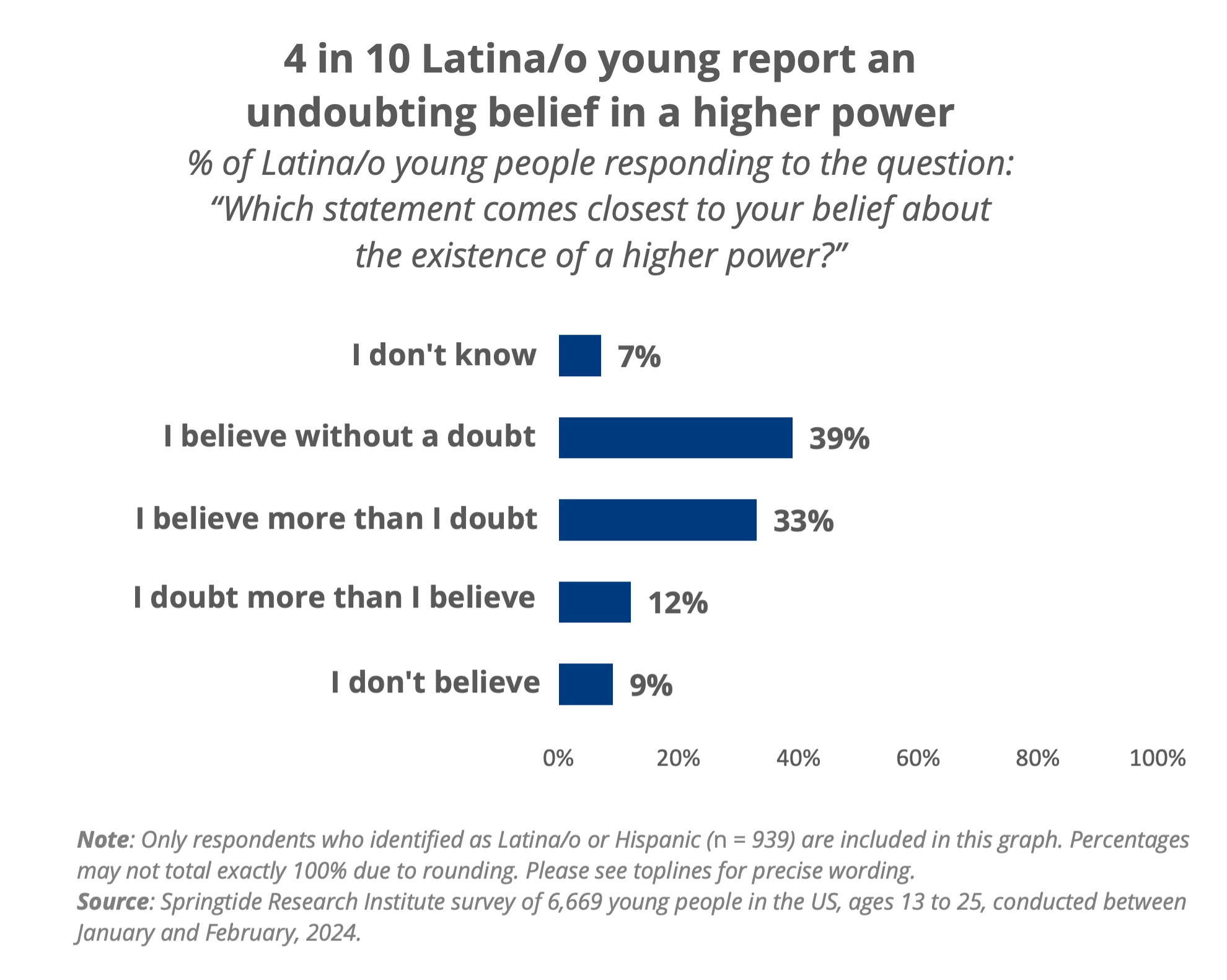
A Religious Snapshot of US Latina/o Youth
Latina/o youth represent a significant portion of the overall population of young people in the US. In fact, data from the US Census Bureau show that 1 in 4 children in the US today is Latina/o.1 While Latina/o immigrants in the US have historically identified as Catholic, religious affiliation tends to vary by immigrant generation.2 What does religion and spirituality look like for today’s US Latina/o youth—most of whom were born in the US?
The Religious Identities of Latina/o Youth
Springtide’s 2024 survey of young people shows that about three-quarters of Latina/o young people surveyed say they are at least slightly religious (77%) or spiritual (79%). Smaller shares identify as very religious (12%) or very spiritual (16%).

In the past year, most Latina/o respondents experienced stability in their level of religiousness. Over half (56%) say they are about as religious now as they were twelve months ago. About a quarter (24%) report they became more religious, while 20% say they became less religious.

The majority of Latina/o teens and young adults identify with a Christian tradition (64%). Most commonly, Latina/o young people identify as Catholic (37%) followed by “Just Christian” (23%). Over a quarter (27%) identify as non-religious: either Atheist, Agnostic, “None,” or as spiritual but not religious.

The salience of religion in Latina/o young people’s lives varies. Nearly half say that religion is either among the most important things (34%) or is the most important thing (11%) in their life. Over a quarter view religion as among the least important thing in their life (13%) or say that it is not important at all (14%). Twenty-eight percent are neutral on the matter, saying religion is neither important nor unimportant in their life.

The Religious Beliefs & Practices of Latina/o Youth
Most Latina/o young people believe in a higher power. In fact, nearly 4 in 10 (39%) tell us they know a higher power exists and have no doubts about it. A third (33%) say they believe in a higher power’s existence more than they doubt, while 12% say they doubt more than they believe. Fewer say they don’t believe in a higher power (9%) or are unsure of what they believe about the existence of a higher power (7%).

When asked about their ties to religious or spiritual communities, Latina/o respondents are almost evenly split. About a third (35%) say they have never been part of such a community, while another third (33%) report they used to be but are no longer involved. A slightly smaller group (32%) say they are currently part of an organized religious or spiritual community.
Half report rarely (28%) or never (20%) attending religious services. Twenty-one percent attend a few times a year, while 12% attend once or twice a month. A smaller portion report attending more regularly—once a week (13%) or more than once a week (5%).

Prayer is a common practice for many. Forty-two percent of Latina/o young people report praying at least once a week or daily. A quarter pray less often, ranging from several times a year (10%) to once or twice a month (15%). One-third say they pray rarely (18%) or never (15%). Larger portions engage in art (61%), spend time in nature (50%), and write (49%) as daily or weekly religious or spiritual practices.

Note: Data presented in this Data Drop come from the 2024 Springtide Study of Young People and Civic Life. See question wording and survey responses in the topline survey results and review methodology here.
1 Jessica Peña, Magdaliz Álvarez Figueroa, Merarys Rios-Vargas, and Rachel Marks. “One in Every Four Children in the United States Were of Hispanic Origin in 2020.” United States Census Bureau, May 2023. https://www.census.gov/library/stories/2023/05/hispanic-population-younger-but-aging-faster.html
2 Jens Manuel Krogstand, Joshua Alvarado, and Besheer Mohamed. “Among U.S. Latinos, Catholicism Continues to Decline but Is Still the Largest Faith.” Pew Research Center, April 2023. https://www.pewresearch.org/religion/2023/04/13/among-u-s-latinos-catholicism-continues-to-decline-but-is-still-the-largest-faith/



